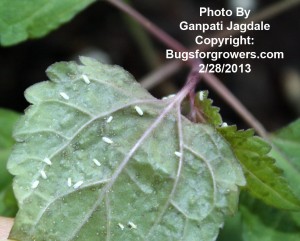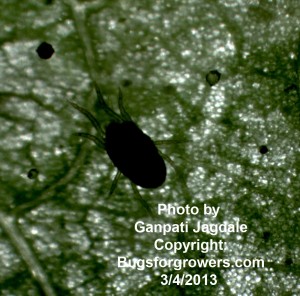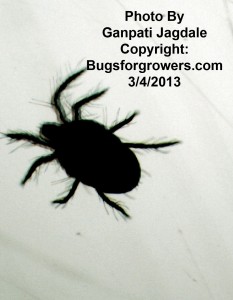Predatory mites Amblyseius swirskii are beneficial insects- Bugsforgrowers
Predatory Mite, Amblyseius swirskii is an excellent biological control agent and has been used in controlling tiny pests such as whiteflies (Fig. 1), thrips and spider mites (Fig.2). that are responsible for causing a serious (Fig. 3) damage to many economically important crops grown both in the greenhouses and fields. Pest (Spider) mites are not considered as insects as they have four pairs of legs (Fig. 4) whereas all insects three pairs of legs.




1. Predatory Mite, Amblyseius swirskii are effective against the following pests
- Asian Citrus Psyllid, Diaphorina citri
- Broad mites, Polyphagotarsonemus latus
- Chilli thrips, Scirtothrips dorsalis
- Greenhouse whitefly, Trialeurodes vaporariorum
- Tobacco whitefly, Bemisia tabaci
- Western flower thrips, Frankliniella occidentalis
- Whitefly eggs and young larvae/nymphs
- Tomato russet mite, Aculops lycopersici
- Twospotted spider mite, Tetranychus urticae
2. Effectiveness of predatory mite, Amblyseius swirskii
- Amblyseius swirskii are natural predators of insect pests and pest mites.
- Amblyseius swirskii are considered as the warm adapted predatory mites because the optimum temperature required for their normal reproduction and development is between 20°C (68°F) and 29°C (84.2°F).
- Because of their warm adaptation capacity, these predatory mites are considered as the ideal biological control agents for controlling whiteflies, thrips or pest mites in the US greenhouses where temperatures often exceed 25oC during summer.
- These mites become sluggish under cooler temperatures but they can become active again when temperature rise.
- However, these mites do not survive under really cold and frosty conditions
- In addition, A. swirskii do not undergo diapause (dormant condition) due to short day-lengths or low temperatures, therefore, they can be used to target pests late in the fall and even in the winter on indoor plants.
3. How predatory mite, Amblyseius swirskii works in the greenhouses or the fields
- Amblyseius swirskii are known to feed voraciously on their hosts like spider mites, thrips and whiteflies.
- After application in the greenhouses or fields, predatory Amblyseius swirskii immediately start munching on their hosts.
- Each mite is capable of consuming 5 larvae of thirps or 15 larvae of whiteflies or 10 eggs of whiteflies per day.
- These mites also consume spider mites, one of the most important pests greenhouse and field crops.
- While feeding, mites develop and reproduce rapidly.
- Under favorable environmental conditions and if there is enough food around, these mite can recycle continuously (do not need to apply again and again) and help to keep the pest population under economic threshold level.
4. Why we need predatory mites, Amblyseius swirskii
- they can reduce the crop damage by feeding on certain crop pests.
- they can munch on different host stages including eggs and larvae of whiteflies and immature stages of thrips.
- they are able to actively search for their hosts and feed on them
- they can reproduce and continue their life cycle on the foliage after first application
- they are commercially available and easy to apply in the greenhouses or fields.
5. Why predatory mites, Amblyseius swirskii are safer than traditional pesticides
- they do not damage plants
- can be used and applied around children and pets
- do not cause any harm to the personnel involved in their production and application
- food products are safe to handle and eat when they are treated with mites
- they do not harm humans, animals and pollute the environment.
Research papers:
Read more papers for more information on the interaction between predatory mites and their insect hosts.
- de Almeida, A.A. and Janssen, A. 2013. Juvenile prey induce antipredator behaviour in adult predators. Experimental and Applied Acarology 59: 275-282.
- Dogramaci, M., Arthurs, S.P., Chen, J.J., McKenzie, C., Irrizary, F. and Osborne, L. 2011. Management of chilli thrips Scirtothrips dorsalis (Thysanoptera: Thripidae) on peppers by Amblyseius swirskii (Acari: Phytoseiidae) and Orius insidiosus (Hemiptera: Anthocoridae). Biological Control 59: 340-347.
- Hoogerbrugge, H., Calvo, J., Houten, Y. and Bolckmans, K., 2005. Biological control of the tobacco whitefly Bemisia tabaci with the predatory mite Amblyseius swirskii in sweet pepper crops. Bulletin OILB/SROP 28, 119–122.
- Juan-Blasco, M., Qureshi, J.A., Urbaneja, A. and Stansly, P.A. 2012. Predatory mite, Amblyseius swirskii (Acari: Phytoseiidae), for biological control of Asian citrus psyllid, Diaphorina citri (Hemiptera: Psyllidae). Florida Entomologist 95: 543-551.
- Kutuk, H., Yigit, A., Canhilal, R. and Karacaoglu, M. 2011. Control of western flower thrips (Frankliniella occidentalis) with Amblyseius swirskii on greenhouse pepper in heated and unheated plastic tunnels in the Mediterranean region of Turkey. African Journal of Agricultural Research 6: 5428-5433.
- Onzo, A., Houedokoho, A.F. and Hanna, R. 2012. Potential of the predatory mite, Amblyseius swirskii to suppress the broad mite, Polyphagotarsonemus latus on the gboma eggplant, Solanum macrocarpon. Journal of Insect Science 12 Article Number: 7.
- Park, H.H., Shipp, L., Buitenhuis, R. and Ahn, J.J. 2011. Life history parameters of a commercially available Amblyseius swirskii (Acari: Phytoseiidae) fed on cattail (Typha latifolia) pollen and tomato russet mite (Aculops lycopersici). Journal of Asia-pacific Entomology 14: 497-501.
- Xiao, Y.F., Avery, P., Chen, J.J., McKenzie, C. and Osborne, L. 2012. Ornamental pepper as banker plants for establishment of Amblyseius swirskii (Acari: Phytoseiidae) for biological control of multiple pests in greenhouse vegetable production. Biological Control 63: 279-286.
- Xu, X. and Enkegaard, A. 2010. Prey preference of the predatory mite, Amblyseius swirskii between first instar western flower thrips Frankliniella occidentalis and nymphs of the twospotted spider mite Tetranychus urticae. Journal of Insect Science 10:149.
